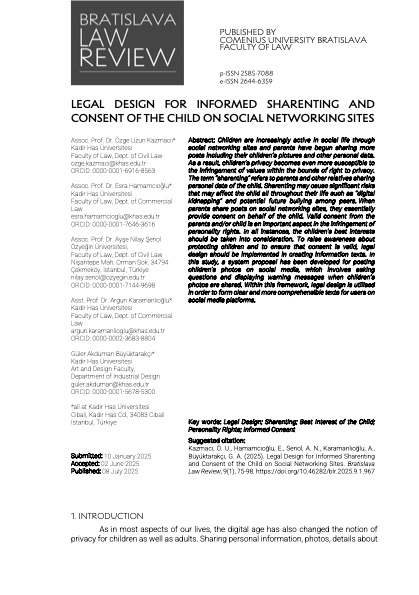Legal Design for Informed Sharenting and Consent of the Child on Social Networking Sites
DOI:
https://doi.org/10.46282/blr.2025.9.1.967Keywords:
Legal Design, Sharenting, Best Interest of the Child, Personality Rights, Informed ConsentAbstract
Children are increasingly active in social life through social networking sites and parents have begun sharing more posts including their children’s pictures and other personal data. As a result, children’s privacy becomes even more susceptible to the infringement of values within the bounds of right to privacy. The term “sharenting” refers to parents and other relatives sharing personal data of the child. Sharenting may cause significant risks that may affect the child all throughout their life such as “digital kidnapping” and potential future bullying among peers. When parents share posts on social networking sites, they essentially provide consent on behalf of the child. Valid consent from the parents and/or child is an important aspect in the infringement of personality rights. In all instances, the children's best interests should be taken into consideration. To raise awareness about protecting children and to ensure that consent is valid, legal design should be implemented in creating information texts. In this study, a system proposal has been developed for posting children’s photos on social media, which involves asking questions and displaying warning messages when children’s photos are shared. Within this framework, legal design is utilised in order to form clear and more comprehensible texts for users on social media platforms.
References
Alberts, W. A. and van der Geest, T. M. (2011). Color matters: Color as Trustworthiness Cue in Web Sites. Technical Communication, 58(2), 149–60.
Aulino, L. (2019). Minors and New Technologies: From Parental Responsibility to Parental Control in Balancing with the Child's Right to Personality. European Journal of Privacy Law & Technologies, (2), 87-94.
Berger-Walliser, G., Barton, T. D. and Haapio, H. (2017). From Visualization to Legal Design: A Collaborative and Creative Process. American Business Law Journal, 54(2), 347-392. DOI: https://doi.org/10.1111/ablj.12101
Blecher-Prigat, A. (2018). Children's Right to Privacy. In: The Oxford Handbook of Children and the Law (pp. 363-391). Oxford: Oxford University Press. DOI: https://doi.org/10.1093/oxfordhb/9780190694395.013.18
Botes, M. and Rossi, A. (2021). Back to the Future with Icons and Images: Using 'Low-Tech' to Communicate and Protect Privacy and Data. In: Ducato, R. and Strowel, A. (Eds), Legal Design Perspectives: Theoretical and Practical Insights from the Field (pp. 209-226). Milan: Ledizioni.
Brosch, A. (2018). Sharenting – Why Do Parents Violate Their Children's Privacy? The New Educational Review, 54(4), 75-85. DOI: https://doi.org/10.15804/tner.2018.54.4.06
Buitelaar, J. C. (2018). Child's best interest and informational self-determination: what the GDPR can learn from children's rights. International Data Privacy Law, 8(4), 293-308, https://doi.org/10.1093/idpl/ipy006 DOI: https://doi.org/10.1093/idpl/ipy006
Chang, W. L. and Lin, H. L. (2010). The impact of color traits on corporate branding. African Journal of Business Management, 4(15), 3344-3355.
Cheung H. (2019). Can you stop your parents sharing photos of you online? In: BBC News. Available at: https://www.bbc.com/news/world-47722427 (accessed on 05.05.2023).
Doherty, M. (2020). Comprehensibility as a rule of law requirement: the role of legal design in delivering access to law. JOAL, 8(1), 1-11.
Donovan, S. (2020). "Sharenting": The Forgotten Children of the GDPR. Peace Human Rights Governance, 4(1), 35-59.
Gabriel, P. (2019). The Protection of Personal Information Act 4 of 2013 and Children's Right to Privacy in the Context of Social Media. Tydskrif vir Hedendaagse Romeins-Hollandse Reg (Journal for Contemporary Roman-Dutch Law), 82(4), 605-620.
Ge, Y., Lu, J., Fan, W. and Yang, D. (2013). Age estimation from human body images. In 2013 IEEE International Conference on Acoustics, Speech and Signal Processing, (pp. 2337-2341). Vancouver: IEEE. DOI: https://doi.org/10.1109/ICASSP.2013.6638072 DOI: https://doi.org/10.1109/ICASSP.2013.6638072
Gligorijević, J. (2019). Children's Privacy: The Role of Parental Control and Consent. Human Rights Law Review, 19(2), 201-229, https://doi.org/10.1093/hrlr/ngz004 DOI: https://doi.org/10.1093/hrlr/ngz004
Goethe W. (1810/1967). Theory of Colours. London: Frank Cass & Co. Ltd.F
Grimes A. and Doole I. (1998). Exploring the relationships between colour and international branding: a cross cultural comparison of the UK and Taiwan. Journal of Marketing Management, 14(7), 799–817, https://doi.org/10.1362/026725798784867581 DOI: https://doi.org/10.1362/026725798784867581
Günüç, S. (2020). Sharenting Eyleminin Psikolojik Açıdan Değerlendirilmesi: Türk ve İngiliz Annelerinin Karşılaştırılması Examining [‘Sharenting’ From a Psychological Perspective: Comparing Turkish and British Mothers], Current Approaches in Psychiatry, 12(1), 281-297, https://doi.org/10.18863/pgy.795651 DOI: https://doi.org/10.18863/pgy.795651
Haapio, H., Campagnucci, M. C., Hagan, M. and Doherty, M. (2021). A new attitude to law's empire: the potentialities of legal design. In: Campagnucci, M. C., Haapio, H., Hagan, M. and Doherty, M. (Eds.), Legal Design (pp. 1-8). DOI: https://doi.org/10.4337/9781839107269.00008 DOI: https://doi.org/10.4337/9781839107269.00008
Hagan, M. (2022). Types of Design, Law by Design. Available at: https://lawbydesign.com/legal-design (accessed on 12.09.2022).
Haley, K. (2020). Sharenting and the (Potential) Right to Be Forgotten. Indiana Law Journal, 95(3), 1005-1020.
Hamamcıoğlu, E. (2022). Hukuk Tasarımı (Legal Design) Kavramı, Gelişimi ve Uygulama Açısından Önemi [Concept of Legal Design, Its Development and Importance for Legal Practice]. Ticaret Hukukunun Güncel Meseleleri 2022 [Current Issues of Commercial Law 2022 Proceedings Book], İstanbul, 49-64.
Hancock, H. (2016) 'Weller & Ors v Associated Newspapers Ltd [2015] EWCA Civ 1176. Weller Case Highlights Need for Guidance on Photography, Privacy and the Press. Journal of Media Law, 8(1), 17-31. DOI: https://doi.org/10.1080/17577632.2016.1188504
Husi-Stämpfli, S. (2021). Kinder im digitalen Raum [Children in the digital space]. Zurich: Schulthess Verlag.
Japharidze, M. (2023). The Best Interests of the Child in the Case Law of the European Courts: Experience for EU Member States and Candidate Countries. International Comparative Jurisprudence 9(1), 24-38, https://doi.org/10.13165/j.icj.2023.06.002 DOI: https://doi.org/10.13165/j.icj.2023.06.002
Jasmontaite, L. and de Hert, P. (2015). The EU, children under 13 years, and parental consent: a human rights analysis of a new, age-based bright-line for the protection of children on the Internet. International Data Privacy Law, 5(1), 20-33, https://doi.org/10.1093/idpl/ipu029 DOI: https://doi.org/10.1093/idpl/ipu029
Kohlmeier, A. and Klemola, M. (2021). The Legal Design Book. Berlin: Meera Klemola and Astrid Kohlmeierr.
Kunz von Hoyningen-Huene, S. and Oberlin, J. S. (2022). Innocence in Danger. Schweizerische Juristen-Zeitung, 23, 1123-1140.
Lipu, M. and Siibak, A. (2019). 'Take it down!': Estonian parents' and pre-teens' opinions and experiences with sharenting. Media International Australia, 170(1), 57-67, https://doi.org/10.1177/1329878X19828366 DOI: https://doi.org/10.1177/1329878X19828366
Mardin, Ç. (2021). Adalete Tasarım Yoluyla Erişmek: Hukuk Tasarımı (Legal Design) Kavramı. KHAS Hukuk Bülteni 2020-2021 Akademik Yılı Derlemesi [KHAS Law Bulletin Compilation for 2020-2021 Academic Year] 121-137.
McKeever, G. and Royal-Dawson, L. (2023). Using human centred design to break down barriers to legal participation. In: Perry-Kessaris, A. and Allbon, E. (Eds.), Design and Visualisation in Legal Education (pp. 135-150). Oxon: Routledge. DOI: https://doi.org/10.4324/9780429021411-13
Montgomery, K. J., Chester, J. and Milosevic, T. (2017). Children's Privacy in the Big Data Era: Research Opportunities. Pediatrics, 140(2), 117-121, https://doi.org/10.1542/peds.2016-1758O DOI: https://doi.org/10.1542/peds.2016-1758O
Moser, C., Chen, T. and Schoenebeck, S.Y. (2017). Parents' and children's preferences about parents sharing about children on social media. Proceedings of the 2017 CHI conference on human factors in computing systems (pp. 5221–5225). https://doi.org/10.1145/3025453.3025587 DOI: https://doi.org/10.1145/3025453.3025587
Murray, M. D. (2021). Diagrammatics and the proactive visualization of legal information. University of Arkansas at Little Rock Law Review, 43(3), 1-50, https://dx.doi.org/10.2139/ssrn.3533412 DOI: https://doi.org/10.2139/ssrn.3533412
Nikken, P. and Schols, M. (2015). How and Why Parents Guide the Media Use of Young Children. Journal of Child Family Studies, 24, 3423–3435, https://doi.org/10.1007/s10826-015-0144-4 DOI: https://doi.org/10.1007/s10826-015-0144-4
OLG Düsseldorf, 20.7.2021 – 1 UF 74/21, par. 12: Zeitschrift für Urheber- und Medienrecht – Rechtsprechungsdienst (2022). 277 ff.
Paal, B. P. and Pauly, D. A. (2021). Beck'sche Kompakt Kommentare Datenschutz Grundverordnung, Bundesdatenschutzgesetz [Beck's Compact Commentaries GDPR, German Federal Data Protection Act]. Munich: C. H. Beck.
Perry, A. and Wisnom, D. (2003). Before the brand: Creating the unique DNA of an enduring brand identity. New York: McGraw-Hill.
Plunkett, L. A. (2019a). To Stop Sharenting & Other Children's Privacy Harms, Start Playing: A Blueprint for a New Protecting the Private Lives of Adolescents and Youth (PPLAY) Act. Seton Hall Legislative Journal, 44(3), 457-486.
Plunkett, L. A. (2019b). Sharenthood: Why We Should Think Before We Talk about Our Kids Online. Cambridge, London: The MIT Press. https://doi.org/10.7551/mitpress/11756.001.0001 DOI: https://doi.org/10.7551/mitpress/11756.001.0001
Ren, L., and Chen, Y. (2018). Influence of color perception on consumer behavior. In: Nah, FH., Xiao, B. (Eds.), HCI in Business, Government, and Organizations: 5th International Conference, HCIBGO 2018, Held as Part of HCI International 2018, Las Vegas, NV, USA, July 15-20, 2018, Proceedings 5 (pp. 413-421). Cham: Springer. DOI: https://doi.org/10.1007/978-3-319-91716-0_32 DOI: https://doi.org/10.1007/978-3-319-91716-0_32
Rossi, A. and Lenzini, G. (2020a). Making the Case for Evidence-based Standardization of Data Privacy and Data Protection Visual Indicators. JOAL, Special Issue on Visual Law, 8(1), 1-16.
Rossi, A. and Lenzini, G. (2020b). Transparency by design in data-informed research: A collection of information design patterns. Computer Law & Security Review, 37, 105402. DOI: https://doi.org/10.1016/j.clsr.2020.105402
Rossi, A. and Palmirani, M. (2020). Can Visual Design Provide Legal Transparency? The Challenges for Successful Implementation of Icons for Data Protection. Design Issues, 36(3) 82-96. DOI: https://doi.org/10.1162/desi_a_00605
Rossi, A., Ducato, R., Haapio, H., Passera, S. and Palmirani, M. (2019). Legal Design Patterns Towards a New Language for Legal Information Design. In: Schweighofer, E., Kummer, F. and Saarenpää, A. (Eds.), Internet of Things, Proceedings of the 22nd International Legal Informatics Symposium (pp. 517-526). IRIS, Bern.
Shepherd, M. (2018). Child Privacy in the Digital Age and California's Child Deletion Statute. Journal of Technology Law & Policy, 23(1), 134-145.
Smith, L. (2018). Woman faces £9,000 fine if she posts pictures of her son on Facebook. Independent. Available at: https://www.independent.co.uk/news/world/europe/facebook-fines-woman-son-photos-post-social-media-court-italyrome-a8155361.html (accessed on: 19.01.2023)
Spindler, G. and Schuster, F. (2019). Recht der elektronischen Medien [Electronic media law]. München: Beck.
Sroka, E. (2022). Infographics in social media. Selected issues. e-mentor, 94(2), 55-64. DOI: https://doi.org/10.15219/em94.1559
Steinberg, S. B. (2017). Sharenting: Children's Privacy in the Age of Social Media. Emory Law Journal, 66(4), 839-884.
Taha, K., Yoo, P. D., Al-Hammadi, Y., Muhaidat, S., and Yeun, C. Y. (2024). Learning a deep-feature clustering model for gait-based individual identification. Computers & Security, 136, 103559, https://doi.org/10.1016/j.cose.2023.103559 DOI: https://doi.org/10.1016/j.cose.2023.103559
Takhshid, Z. (2023). Children's digital privacy and the case against parental consent. Texas Law Review, 101(6), 1417-1456.
Tredwell, S. (2021). Typography and Legal Information. Slaw. Available at: https://www.slaw.ca/2016/09/08/typography-and-legal-information/ (accessed on: 10.01.2025).
Turgut, C. (2021). Genişletilmiş Benlik Teorisi Perspektifinde Velayet Alıtndaki Küçüğün Görüntüsünün Sosyal Ağ Sitelerinde Paylaşılmasının Hukuki Yönü [Legal Aspect of Sharing the Image of a Minor in Custody on Social Network Sites in the Perspective of the Extend Self Theory: Sharenting]. In: Assoscongress 7 International Symposium on Law (27-29 May 2021) Conference Proceedings (pp. 679-689). Eskişehir: Asos Yayınevi.
Wagner, A. and Gasche, L. A. (2018). Sharenting: Making Decisions about Other's Privacy on Social Networking Sites. Multikonferenz Wirtschaftsinformatik (March 06-09, 2018) Tagungsband V. III (pp. 977-988). Lüneburg: Leuphana Universität.
Walser Kessler, C. (2015). Visualisierung des Rechts im digitalen Zeitalter. Recht im digitalen Zeitalter (pp. 145-164). Zürich/St. Gallen: Dike Verlag.
Wells, G., Horwitz, J. and Seetharaman, D. (2021). Facebook Knows Instagram Is Toxic for Teen Girls, Company Documents Show. Wall Street Journal . Available at: (accessed on 29.07.2023).
Williams-Ceci, S., Grose, G. E., Pinch, A. C., Kizilcec, R. E. and Lewis, N. A. (2021). Combating sharenting: Interventions to alter parents' attitudes toward posting about their children online. Computers in Human Behavior, 125, 1-10, https://doi.org/10.1016/j.chb.2021.106939 DOI: https://doi.org/10.1016/j.chb.2021.106939
Wu, Q., and Guo, G. (2013). Age classification in human body images. Journal of Electronic Imaging, 22(3), 033024-033024, https://doi.org/10.1117/1.JEI.22.3.033024 DOI: https://doi.org/10.1117/1.JEI.22.3.033024
Yüksel A. (2009). Exterior color and perceived retail crowding: effects on tourists' shopping quality inferences and approach behaviors. Journal of Quality Assurance in Hospitality and Tourism, 10(4), 233–254, https://doi.org/10.1080/15280080903183383 DOI: https://doi.org/10.1080/15280080903183383
Zorluoğlu Yılmaz, A. (2021). Sharenting and Limits of Custody. Selçuk Law Review, 29(4), 3318-3417.
Stanford legal design lab's legal design toolbox. Available at: https://legaltechdesign.com/LegalDesignToolbox (accessed on 30.04.2025).

Downloads
Published
License
Copyright (c) 2025 Bratislava Law Review

This work is licensed under a Creative Commons Attribution-NonCommercial-NoDerivatives 4.0 International License.
The Author(s) transfers copyright to the Article to the Publisher of the Journal by the Licence Agreement.
The Author(s) retains rights specified in the Licence Agreement.
The readers may read, download, copy, distribute, print, search, or link to the full texts of all of the Article of the Journal and use them for any other lawful purpose under specified Creative Commons Licence (CC BY-NC-ND 4.0).











